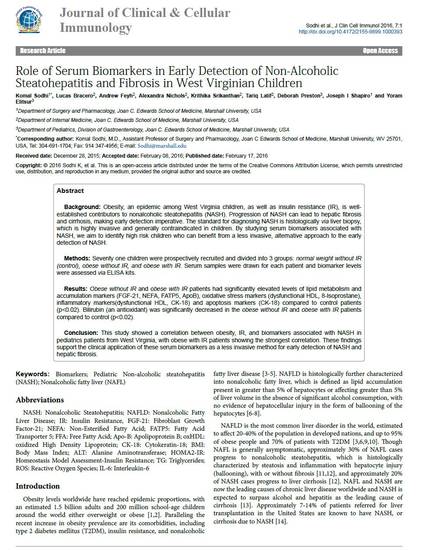
Article
Role of Serum Biomarkers in Early Detection of Non-Alcoholic Steatohepatitis and Fibrosis in West Virginian Children
Journal of Clinical & Cellular Immunology
(2016)
Abstract
Background: Obesity, an epidemic among West Virginia children, as well as insulin resistance (IR), is well established contributors to nonalcoholic steatohepatitis (NASH). Progression of NASH can lead to hepatic fibrosis and cirrhosis, making early detection imperative. The standard for diagnosing NASH is histologically via liver biopsy, which is highly invasive and generally contraindicated in children. By studying serum biomarkers associated with NASH, we aim to identify high risk children who can benefit from a less invasive, alternative approach to the early detection of NASH.
Methods: Seventy one children were prospectively recruited and divided into 3 groups: normal weight without IR (control), obese without IR, and obese with IR. Serum samples were drawn for each patient and biomarker levels were assessed via ELISA kits.
Results: Obese without IR and obese with IR patients had significantly elevated levels of lipid metabolism and accumulation markers (FGF-21, NEFA, FATP5, ApoB), oxidative stress markers (dysfunctional HDL, 8-Isoprostane), inflammatory markers(dysfunctional HDL, CK-18) and apoptosis markers (CK-18) compared to control patients (p<0.02). Bilirubin (an antioxidant) was significantly decreased in the obese without IR and obese with IR patients compared to control (p<0.02).
Conclusion: This study showed a correlation between obesity, IR, and biomarkers associated with NASH in pediatrics patients from West Virginia, with obese with IR patients showing the strongest correlation. These findings support the clinical application of these serum biomarkers as a less invasive method for early detection of NASH and hepatic fibrosis.
Keywords
- Pediatric Non-alcoholic steatohepatitis (NASH),
- Nonalcoholic fatty liver (NAFL)
Disciplines
Publication Date
February 17, 2016
DOI
10.4172/2155-9899.1000393
Citation Information
Komal Sodhi, Lucas Bracero, Andrew Feyh, Alexandra Nichols, et al.. "Role of Serum Biomarkers in Early Detection of Non-Alcoholic Steatohepatitis and Fibrosis in West Virginian Children" Journal of Clinical & Cellular Immunology (2016) ISSN: 2155-9899 Available at: http://works.bepress.com/komal_sodhi/31/
